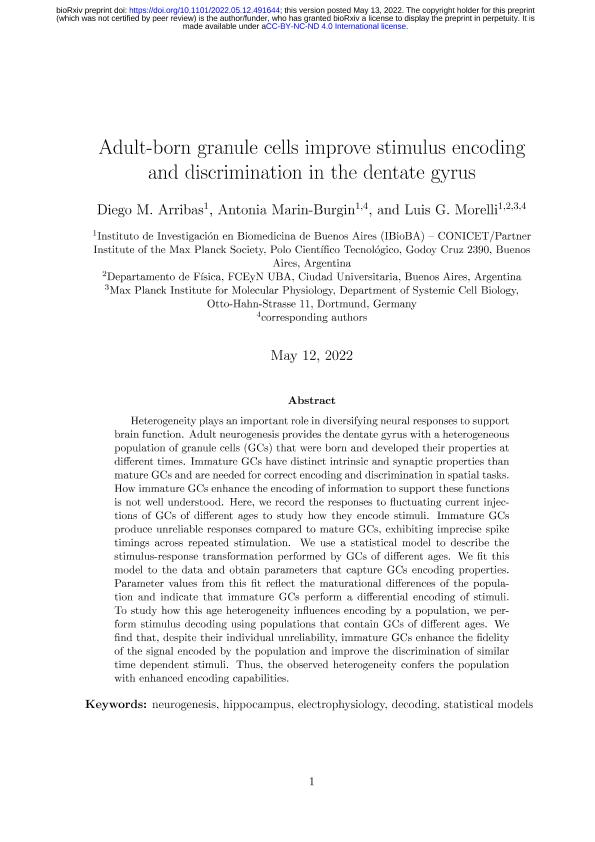Mostrar el registro sencillo del ítem
dc.contributor.author
Arribas, Diego Martín

dc.contributor.author
Marin Burgin, Antonia

dc.contributor.author
Morelli, Luis Guillermo

dc.date.available
2023-10-25T13:50:56Z
dc.date.issued
2022-09
dc.identifier.citation
Arribas, Diego Martín; Marin Burgin, Antonia; Morelli, Luis Guillermo; Adult-born granule cells improve stimulus encoding and discrimination in the dentate gyrus; Cold Spring Harbor Laboratory Press; BioRxiv; 2022; 9-2022; 1-28
dc.identifier.issn
2692-8205
dc.identifier.uri
http://hdl.handle.net/11336/215850
dc.description.abstract
Heterogeneity plays an important role in diversifying neural responses to support brain function. Adult neurogenesis provides the dentate gyrus with a heterogeneous population of granule cells (GCs) that were born and developed their properties at different times. Immature GCs have distinct intrinsic and synaptic properties than mature GCs and are needed for correct encoding and discrimination in spatial tasks. How immature GCs enhance the encoding of information to support these functions is not well understood. Here, we record the responses to fluctuating current injections of GCs of different ages to study how they encode stimuli. Immature GCs produce unreliable responses compared to mature GCs, exhibiting imprecise spike timings across repeated stimulation. We use a statistical model to describe the stimulus-response transformation performed by GCs of different ages. We fit this model to the data and obtain parameters that capture GCs encoding properties. Parameter values from this fit reflect the maturational differences of the population and indicate that immature GCs perform a differential encoding of stimuli. To study how this age heterogeneity influences encoding by a population, we perform stimulus decoding using populations that contain GCs of different ages. We find that, despite their individual unreliability, immature GCs enhance the fidelity of the signal encoded by the population and improve the discrimination of similar time dependent stimuli. Thus, the observed heterogeneity confers the population with enhanced encoding capabilities.
dc.format
application/pdf
dc.language.iso
eng
dc.publisher
Cold Spring Harbor Laboratory Press

dc.rights
info:eu-repo/semantics/openAccess
dc.rights.uri
https://creativecommons.org/licenses/by-nc-nd/2.5/ar/
dc.subject
ADULT NEUROGENESIS
dc.subject
HIPPOCAMPUS
dc.subject
MODELING
dc.subject
ELECTROPHYSIOLOGY
dc.subject.classification
Neurociencias

dc.subject.classification
Medicina Básica

dc.subject.classification
CIENCIAS MÉDICAS Y DE LA SALUD

dc.title
Adult-born granule cells improve stimulus encoding and discrimination in the dentate gyrus
dc.type
info:eu-repo/semantics/article
dc.type
info:ar-repo/semantics/artículo
dc.type
info:eu-repo/semantics/publishedVersion
dc.date.updated
2023-07-10T11:52:19Z
dc.journal.volume
2022
dc.journal.pagination
1-28
dc.journal.pais
Estados Unidos

dc.description.fil
Fil: Arribas, Diego Martín. Consejo Nacional de Investigaciones Científicas y Técnicas. Oficina de Coordinación Administrativa Parque Centenario. Instituto de Investigación en Biomedicina de Buenos Aires - Instituto Partner de la Sociedad Max Planck; Argentina
dc.description.fil
Fil: Marin Burgin, Antonia. Consejo Nacional de Investigaciones Científicas y Técnicas. Oficina de Coordinación Administrativa Parque Centenario. Instituto de Investigación en Biomedicina de Buenos Aires - Instituto Partner de la Sociedad Max Planck; Argentina
dc.description.fil
Fil: Morelli, Luis Guillermo. Consejo Nacional de Investigaciones Científicas y Técnicas. Oficina de Coordinación Administrativa Parque Centenario. Instituto de Investigación en Biomedicina de Buenos Aires - Instituto Partner de la Sociedad Max Planck; Argentina. Universidad de Buenos Aires. Facultad de Ciencias Exactas y Naturales. Departamento de Física; Argentina. Max Planck Institute for Molecular Physiology; Alemania
dc.journal.title
BioRxiv
dc.relation.alternativeid
info:eu-repo/semantics/altIdentifier/url/https://www.biorxiv.org/content/10.1101/2022.05.12.491644v1
dc.relation.alternativeid
info:eu-repo/semantics/altIdentifier/doi/https://doi.org/10.1101/2022.05.12.491644
Archivos asociados
